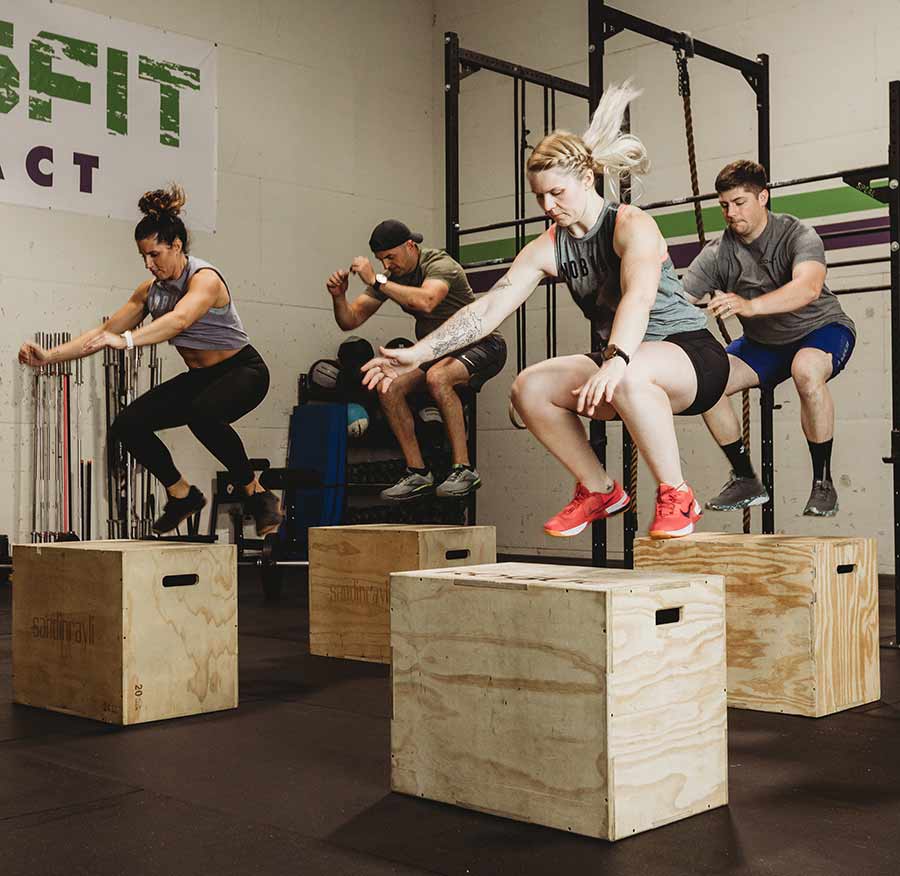
If you’ve been at our box for longer than ten minutes, it’s safe to say you’ve heard the terms “RX and Scaled” thrown around quite a bit.
What do they mean and how does it apply to YOU as an athlete? Keep reading! We’re going to cover all the things you need to know about RX and Scaled workouts.
What’s all this talk about RX?
We’ve all seen the term “RX” before, especially when tied to the medical field. RX is the shorthand of the Latin term recipere, which means “to take”. The word was later abbreviated to RX as we know it today.
In CrossFit, RX has a similar meaning. Essentially, you’re completing the WOD (Workout of the Day) as it was written. All movements, as well as the weight/height, and prescribed number of reps to the full standards of each movement is completed “as prescribed”.
Before we go any further, take note that it is completely okay and often extremely appropriate that many of our members do not perform workouts “as prescribed”.
Let’s use an example of a workout we’ve done multiple times here at CrossFit Artifact:
The workout is CINDY. Cindy is a longer, lower intensity workout that tests skill and stamina.
20 MIN AMRAP (as many reps as possible in 20 minutes)
5 pull-ups
10 push-ups
15 air squats
We’ll use three athletes (Athlete A, Athlete B, and Athlete C) as our example. You might find you can identify with one of these athletes when considering how you would approach this workout.
Athlete A can complete upwards of 25 rounds of Cindy in the 20 minute window. None of the movements present a challenge, so they’re going to go as fast as they can to complete as many rounds and reps as possible. There isn’t a movement prescribed that will slow them down. Athlete A is going to RX this workout.
Athlete B is able to complete 8-10 rounds of Cindy. Pull-ups and push-ups may cause a hangup, as these aren’t strong movements for them. They’re able to get through them, but they may end up breaking the movements up toward the last few rounds. Athlete B is going to RX this workout.
Athlete C is unable to complete pull-ups or push-ups from their toes. They expect to complete 8+ rounds of Cindy in the allotted 20 minute window. Ring rows and push-ups from their knees will allow Athlete C to move intentionally and at a good pace. Athlete C is going to Scale this workout.
Are all three athletes completing the same workout? Yes and no.
For Athlete A, Cindy becomes a cardio workout. For Athlete B, Cindy will be more of a strength workout. Athlete C will be somewhere in the middle.
How do you decide whether to RX or Scale?
Sometimes it’s not as cut and dry as can I do an RX pull-up? We need to consider a few factors when deciding what’s appropriate for a given workout.
There are occasions when it’s an easy decision. If you can’t get your chin over the bar for pull-ups and push-ups from your toes are extremely challenging, it’s probably not a good idea to attempt to RX Cindy. You won’t complete as many round and reps which will alter the stimulus of the workout.
What happens if you can perform the movements or you can lift the RX weight? Let’s take a look at another workout for this next example.
The workout is FRAN. Fran is a short workout (it should take you 9 minutes or less to complete) with the intended stimulus being to work with a high heart rate, complete thrusters and pull-ups in larger sets, and complete these movements as close to unbroken as possible.
21-15-9
Barbell Thrusters (95/65#)
Chin-over-bar Pull-ups
This seems simple enough, right? Let’s look at a few examples.
Athlete A is unable to perform a 95# thruster. This athlete is able to complete a set of 5 thrusters at 75#, but it’s challenging to reach full depth (below parallel, meaning your hip crease is below your knee crease when in a squat), however, pull-ups are not a problem.
Athlete B is able to perform 3 sets of 21 thrusters at 65#, but the remaining sets of 15 and 9 will be a challenge due to fatigue. The RX weight is heavy. Pull-ups are doable, but challenging. Athlete B will likely be able to complete sets of 2-3 unbroken pull-ups throughout the workout.
Athlete C can complete all thrusters unbroken at the prescribed weight of 95#. Pull-ups become more of a challenge, but Athlete C is able to hold onto bigger sets and may be able to complete the first set of 21 unbroken.
Which athletes should consider scaling and which should RX to preserve the intended stimulus of working with a high heart rate and completing the movements in larger sets?
Scaling isn’t a dirty word.
We do CrossFit. Of COURSE everyone wants to click that RX button at the end of the WOD. That’s part of what makes CrossFit so great. Regardless of how long you’ve been doing it, there is always room for improvement.
Scaling is like an individualized program for the more generalized RX version of the workout. It’s not a bad thing! It’s pretty awesome to be able to personalize each workout so that it fits YOU as an athlete exactly where you are in your fitness journey.
Our coaches are experts in scaling any movement for any athlete. Why? Because it’s SO IMPORTANT that our athletes are completing the workouts, but also hitting the intended stimulus of each workout, too! If you’re going to get bogged down with an RX weight and get half the reps in that are intended, it’s not always a benefit to you. There are, of course, workouts where it’s fine to test out a weight you may not be as comfortable with, but for the most part, the intended stimulus is a priority.
Attempting to rush into RX before you’re truly ready may not build your strength as quickly or as much as it could be, AND, it may push your technique and form to the back burner. Neither of these will get you to your goals as quickly.
At CrossFit Artifact, we value longevity when it comes to your fitness journey. It is our goal to scale and train appropriately so that skills and technique can be built as a solid foundation on which to build. Taking a step back now will pay off to a more efficient workout later!
Completing movements “as prescribed” and meeting all of the movement standards (regardless of whether you RX or Scale) makes you a better athlete…an athlete with integrity! The standard is the standard!
How do I become an RX athlete?
Having a goal is an amazing thing. If your goal is to become an RX athlete, that’s awesome!
If you’re in doubt about whether to RX or Scale, ask a coach! Our coaches know the intended stimulus of the workout and will be able to help guide you in your decision.
If you’re in doubt about whether to RX or Scale, it’s usually best to err on the side of going lighter in weight. Deciding whether to RX or Scale movements such as pull-ups, push-ups and the like may take a little more thought. Once again, ask a coach! Scaling is an ever changing progression, so it’s a good idea to check with your coach to see if it’s a good time to move on up on the progression ladder!
Lastly, being consistent and showing up for class 4-6 times per week is a great way to improve not only in completing workouts RX, but in your overall fitness.
You may not notice progress right away, but being consistent is a snowball effect. Results WILL come!
We believe this to be true SO MUCH that we reward our members who are COMMITTED with our monthly Committed Club.
Artifact members who attend 16 classes in a month are automatically entered into a monthly drawing for an amazing prize. If you do the math, that’s just about 4 classes each week.
Each quarter, the prizes get bigger, and so do the wins, both inside the gym and out.
Are you ready to make a change?
A lot of times, getting started is the hardest part. We’ve made it easy to give CrossFit a try. Want to stop in for a tour of our facility? We’d love to show you around! Ready to jump in to a FREE class? Awesome! In the area and want to get a workout in? It’d be awesome to have you drop in!



